1. Background of the Activity
In 2019, the Central Committee of the Communist Party of China and the State Council issued the “Opinions on Deepening Educational and Teaching Reform to Improve the Quality of Compulsory Education” which pointed out that the quality of compulsory education is related to the healthy growth of millions of children, national development, and the future of the nation. It is necessary to deepen educational and teaching reforms from multiple aspects to comprehensively improve the quality of compulsory education. In 2023, the Shanghai Municipal Education Commission issued the “Guiding Opinions on Implementing Project-Based Learning to Promote Reform in the Educational Approach of Compulsory Education,” which stated that in order to deeply implement the requirements of educational reform, project-based learning should be further implemented, with a goal of covering all schools in the compulsory education stage by 2024 and normalizing project-based learning in compulsory education schools by 2026.
Shanghai Xinjing Middle School is one of the project-based experimental schools in Changning District. To address the questions students encounter in real life, the author developed an interdisciplinary project-based learning activity combining the school’s ecological practice base and virtual digital space, which deepened students’ understanding of biological concepts and the Internet of Things, while enhancing their ability to explore and solve problems using integrated knowledge.




2. Activity Content
1. Activity Space
(1) Open Learning Environment: The school’s ecological practice base has always been an innovative interdisciplinary project-based learning activity base. This activity mainly utilizes the modern glass greenhouse in the base to simulate a sunny windowsill environment, where students design and create a growth rack for smart flower period control, and conduct testing and improvements.
(2) Virtual Digital Learning Space: Micro:bit Programming Website
The Micro:bit programming website is a free and open programming virtual space. Using this virtual environment, students can utilize the temperature and optical sensors on the Micro:bit development board to design programs for flower period control based on the blooming temperature and light requirements of certain flowers (Figure 1).
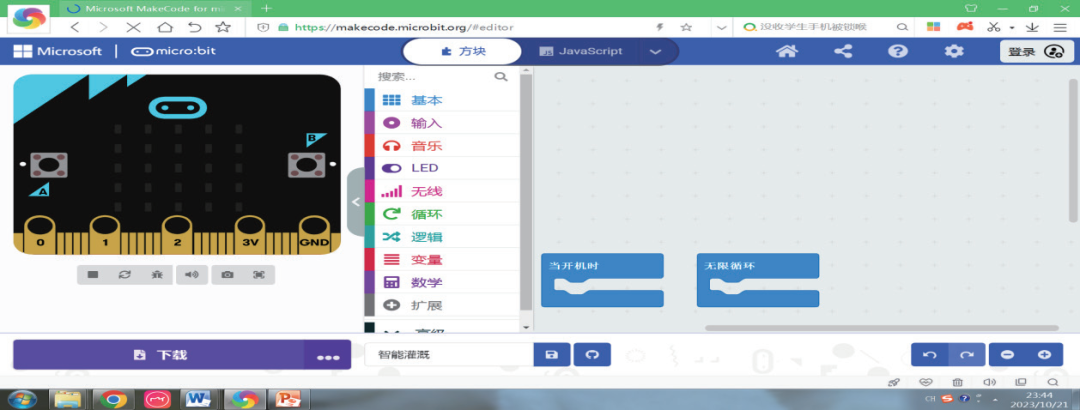
Figure 1 Micro:bit Programming Website Interface
2. Activity Objectives
According to the “Compulsory Education Biology Curriculum Standards (2022 Edition),” this project mainly targets the theme seven “Biology and Society • Interdisciplinary Practice” in the 2022 new curriculum standards for junior high school biology, specifically concept 9.2 on interdisciplinary practice activities related to plant cultivation and animal husbandry: Plant cultivation and animal husbandry can comprehensively apply knowledge and methods from multiple disciplines to design appropriate devices to meet the growth needs of organisms. The optional project 2 proposes exploring the control of plant cultivation conditions.
According to the “Compulsory Education Information Technology Curriculum Standards (2022 Edition),” this project corresponds to the second part of the fourth stage (grades 7-9) in the 2022 new curriculum standards, specifically the fourth module “IoT Practical Exploration”: Based on the needs of learning tasks and available experimental equipment, design and build a simple IoT system with data collection, real-time transmission, and simple control functions. The fourth part “Interdisciplinary Thematic Interconnected Intelligent Design” also mentions the need to comprehensively apply knowledge from information technology and biology, allowing students to think across disciplines and develop integrated thinking and innovative awareness.
Based on the guidance of the new curriculum standards, the activity objectives of this project are set to solve the question “How to extend the flowering period of potted flowers at home?” By combining the blooming conditions of a specific plant, students will design a feasible research plan, creatively utilize materials, and design appropriate devices to extend the flowering period, practicing and continuously improving the device or control program.
3. Activity Preparation
The activity needs to be prepared according to the different needs of students at various stages, rather than being designed and prepared in advance by the teacher. Materials for the main structure of the windowsill flower growth rack need to be prepared: metal mesh, twist sticks, small flower pots, water pipes, scissors, tape, supplementary light, heating lamps, solar panels, batteries, wires, water tanks, pumps, and troughs; software and hardware support also needs to be provided for students to establish a simple IoT system: networked computers, Micro:bit development boards, relays, soil moisture sensors, and GPS-8G remote light, temperature, and humidity meters, as well as notebooks for recording processes and results and evaluation forms for reflection.
4. Activity Process
(1) Problem Generation
Students noticed that the azaleas planted in the glasshouse of the ecological practice base bloom longer than those at home, and some students found that the blooming times of azaleas in front of and behind the teaching building were different, which sparked students’ attention and discussion: How to control the flowering period of azaleas? This project arose to address this problem.
(2) Activity Design and Implementation
① Design of the Flower Growth Rack
The teacher guided students to select a planting method suitable for most students’ home environments that minimizes the impact on living space, using questions to lead students to search for the conditions required for flower blooming using tablets, and to discuss and conclude that the blooming of flowers is mainly affected by multiple factors such as light and temperature.
The teacher continued to pose the question: How to meet the light and temperature conditions required for blooming when planting flowers on the windowsill? The teacher guided each group to reasonably divide tasks, design, discuss, and improve the production plan for the windowsill growth rack, and encouraged students to think about whether the growth rack is safe, whether it will affect window opening, and the impact of light on the position of the planting pots, etc. After presentations from each group, design optimization was conducted.
② Building the Flower Growth Rack
The teacher provided materials based on the students’ design needs and assisted each group in making the flower growth rack, continuously supplementing materials according to students’ production needs (Figure 2).
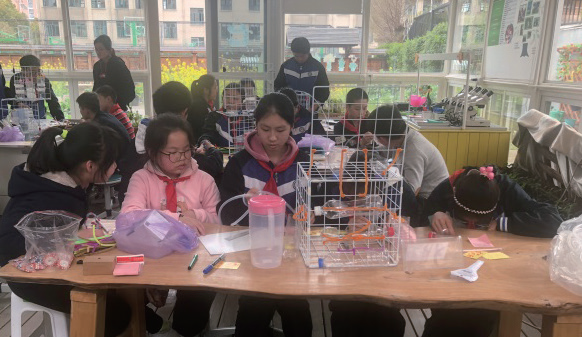
Figure 2 Using Materials to Make the Flower Rack
③ Adding Intelligent Control System
Through the problem framework, students were guided step by step to think about how to design the control of light and temperature to extend the flowering period. Students concluded that intelligent control components, growth supplementary lights, heating lamps, pumps, pipes, and water tanks are needed, and some students even suggested using sunlight from the sunny windowsill as a power source, so solar panels and batteries are also required. After reaching a consensus, the teacher provided materials and guided students to install the lighting, heating, and irrigation systems on the growth rack according to the optimized plan (Figures 3 and 4).
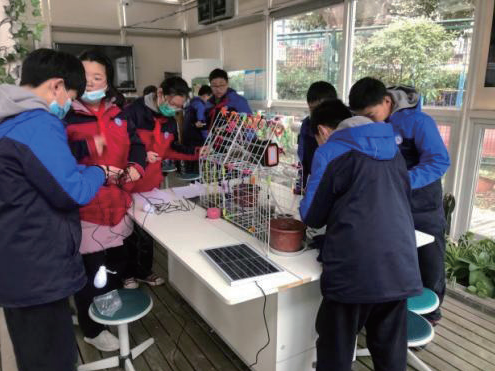
Figure 3 Installing Intelligent Control Components
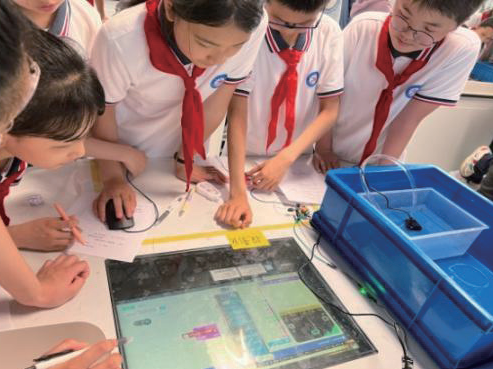
Figure 4 Writing Light and Temperature Control Program
First, based on the students’ preliminary investigation, it was found that the optimal blooming conditions for azaleas are around 25°C and 10-12 hours of light (in winter). To help students meet the requirement of setting conditions to control the flowering period, the teacher provided the Micro:bit development board (which has built-in light and temperature sensors), relays, and soil sensors, and organized students to learn how to program with Micro:bit. They first built a system with the Micro:bit and heating lamp, setting the suitable temperature for azalea blooming at 25°C, controlling and testing the temperature conditions so that the heating lamp turns on when below 25°C and turns off when above 25°C.
Next, they connected the growth supplementary light circuit in parallel on the development board, also using the built-in optical sensor of the Micro:bit, setting a program to provide additional light for azaleas at night, monitoring daily, and when the light intensity is below the set value, the supplementary light will turn on for 3 hours, ensuring the plants receive a minimum of 10-12 hours of light each day.
Finally, they connected the Micro:bit to the water pump with the installed relay, and wrote a program to control water supply using the soil moisture sensor. Based on the researched data, the system monitors daily, and when the soil moisture is below the preset value, it will perform a drip irrigation to ensure the soil moisture is at an appropriate level, completing the application layer functions of the intelligent flower growth rack for light, temperature, and irrigation control (Figures 5 and 6).
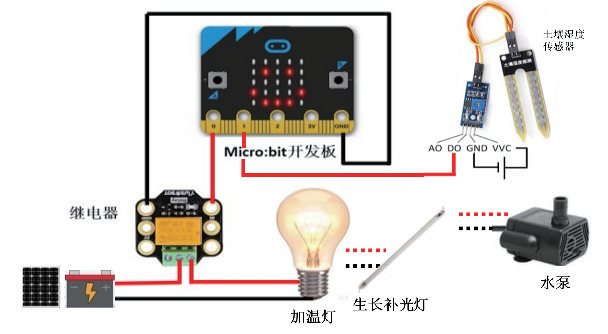
Figure 5 Device Assembly Diagram
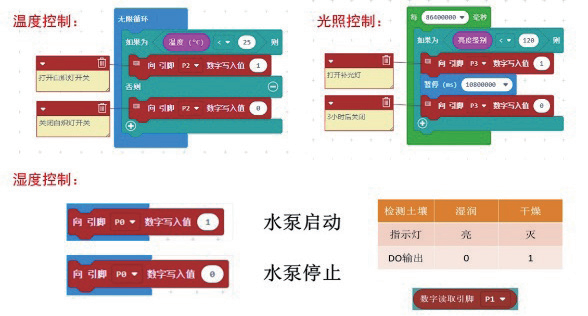
Figure 6 Control Program Code Snippet
④ Building the IoT System
At this point, a smart flower period control growth rack capable of automatic supplementary lighting, temperature control, and automatic watering has been completed. However, the data on light, temperature, and humidity cannot be collected and analyzed, making it inconvenient to adjust the control program content on the Micro:bit programming website in a timely manner. Therefore, the teacher organized students to search online for suitable data collection tools, and after comparing various indicators, they chose the GPS-8G remote light, temperature, and humidity meter, which comes with a free 4G card and can work without wireless network restrictions. By simply downloading an app on their phones, they can perform remote real-time monitoring, collect light, temperature, and humidity data, and receive alerts for exceeding limits or power outages, effectively adding a sensing layer function; the collected data can be used to continuously modify the program to meet blooming conditions. This introduced the network layer, completing the three-layer architecture deployment of the simple IoT system, allowing students to improve devices and record practices during breaks and lunch (Figures 7 and 8).
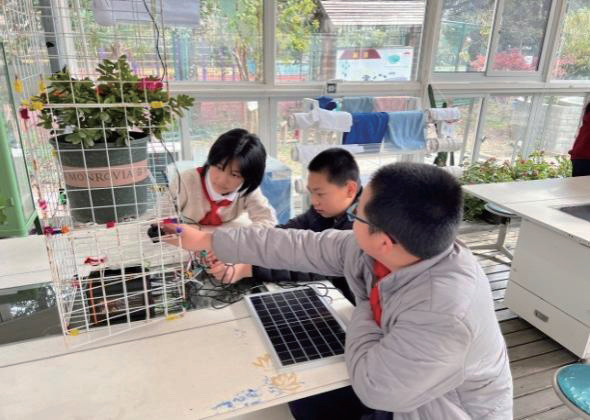
Figure 7 Improving Control Devices
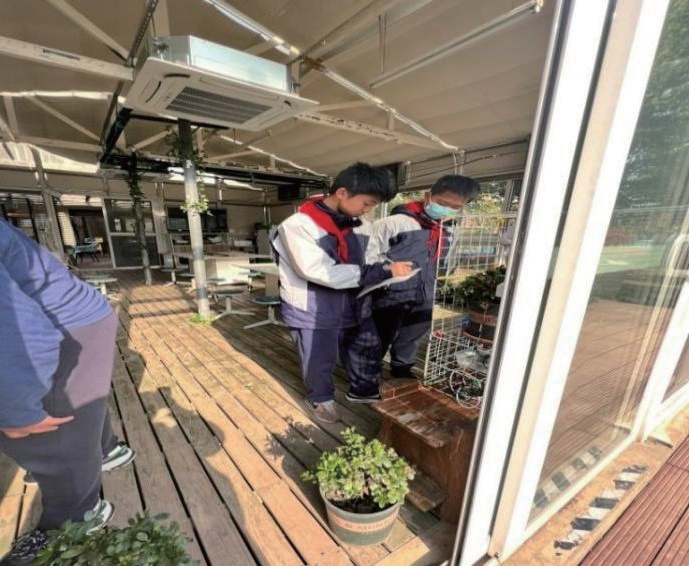
Figure 8 Conducting Flowering Comparison Tests
5. Activity Evaluation
In addition to testing whether the self-made flower period control growth rack can regulate the flowering period of azaleas to evaluate the practicality of the work, students were also organized to take the growth rack home for further improvements, cultivating more flowers; at the same time, evaluations were conducted on the campus public account and campus TV station; then, devices with better flowering control effects were recommended to participate in the Shanghai Youth Innovation Competition and other events to receive more expert guidance and evaluation.




3. Activity Effectiveness
1. Promoting Autonomous Learning and Extending Learning Space
Students typically do not participate in the design of learning activities, but this activity originated from questions raised by students: the azaleas at home have stopped blooming, while those in the school’s glasshouse are in full bloom, which also sparked other students’ thoughts on the different blooming times of azaleas in front of and behind the teaching building: What conditions are needed for blooming, and how to control the flowering period. The teacher guided students to use integrated knowledge to solve problems, and based on each group’s investigations, discussions, and exchanges, they decided on the subsequent learning activity content, with results that can solve real problems, allowing students to truly become the main body of learning and stimulating their desire for active learning. After the activity, students could also take the flower period control growth rack home for further testing and optimization, extending the learning space from school to real life, further broadening the dimensions and depth of students’ learning space.
2. Creating an Inquiry Environment and Enhancing Integrated Thinking
The guiding teacher did not directly provide answers to the questions raised by students but instead set up frameworks, guiding students to think, communicate, design, and practice, encouraging student innovation. This approach helped students establish a good environment for autonomous inquiry into problems. Ultimately, through practical comparisons, it was found that the flower period control growth rack indeed regulated the flowering period of azaleas and enabled students to use what they learned to analyze the reasons for the different blooming times of azaleas in front of and behind the teaching building, forming a positive knowledge learning loop.
This activity differs from traditional learning methods that answer students’ practical questions from a single disciplinary perspective; instead, it uses an interdisciplinary project-based approach, integrating information technology, allowing students to understand biological problems from multiple angles and recognize that technology can solve problems. This teaching method not only addresses students’ motivation issues but also enhances their integrated thinking methods.
3. Experiencing Problem Solving and Appreciating Subject Integration
This interdisciplinary project-based learning utilized information technology to provide students with a platform for learning and practicing new technologies and using information technology to solve real problems. Students can program and design through the Micro:bit programming website, acquiring basic programming knowledge and enhancing their inquiry and practical skills in information technology. During the activity, students need to master and use hardware such as the Micro:bit development board, GPS-8G light, temperature, and humidity meter, relays, and soil moisture sensors; they also need to understand device characteristics and learn to program software to control automated devices, achieving intelligent monitoring and control of the flower growth environment.
Students took the actual topic of flower period control, combining knowledge of biology and information technology to analyze, design, and create a smart growth rack to solve problems. This process trained students’ problem-solving and innovation abilities, deepening their understanding of the activity space and virtual resources, making them aware of the importance and value of subject knowledge integration and application, promoting the comprehensive application of subject knowledge.
4. Discovering Personal Potential and Igniting Learning Interest
Students typically follow teachers to participate in learning activities, which often limits their exploration of their own abilities and interests. However, in this activity, students first learned biology and information technology knowledge based on the problems, and then used this knowledge to solve practical problems, making learning interesting and enhancing their subjective initiative.
In the process of practice, students unconsciously discover various potentials, such as drawing design, presentation expression, transforming design drawings into devices, circuit modifications, and flower cultivation; some students who performed poorly in basic courses also demonstrated good hands-on practice and expression abilities during the activity, receiving praise and attention from guiding teachers, leading to significant changes in their learning attitudes; some students even discovered their talent for programming through the activity. Participating in this activity also helped students better discover their interests, providing strong assistance for them to recognize and understand themselves, and even planting a seed for future professional or career choices.




4. Limitations and Reflections
This activity was jointly guided by biology and information technology teachers within the school. If more questions could be set to guide students to think in more directions, and if other subject teachers or social resources could be added, it would greatly help students’ improvement in thinking and cognition. In the future, the design of guiding questions for activities will be prioritized, and efforts will be made to seek multiple forces to allow students to comprehensively access and understand real society, thereby better mastering problem-solving methods.
During the implementation of this activity, only one practical problem of the extended class students was solved. In the future, a school-level “Good Questions” collection mechanism can be created as an opportunity to create more conditions, expanding the benefits to allow more students to participate in personalized interdisciplinary project activities, such as extending to establish a class intelligent biology corner, etc. Additionally, school resources can be opened to students from surrounding schools and communities to jointly conduct interest exploration activities, contributing to enhancing students’ comprehensive qualities.
Author Introduction: Zhai Nan, Master’s Degree, First-Class Teacher; Fan Bo, Bachelor’s Degree, First-Class Teacher. Shanghai Xinjing Middle School, 200335